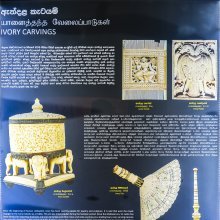Kamba, Kāmbā: 11 definitions
Introduction:
Kamba means something in Hinduism, Sanskrit, the history of ancient India, Marathi, Jainism, Prakrit, biology. If you want to know the exact meaning, history, etymology or English translation of this term then check out the descriptions on this page. Add your comment or reference to a book if you want to contribute to this summary article.
Images (photo gallery)
In Hinduism
Purana and Itihasa (epic history)
Source: Wisdom Library: Varāha-purāṇaKāmbā (काम्बा).—Name of a river (nadī) situated near the seven great mountains on the western side of mount Naiṣadha, according to the Varāhapurāṇa chapter 83. These settlements consume the water flowing from these seven great mountains (Viśākha, Kambala, Jayanta, Kṛṣṇa, Harita, Aśoka and Vardhamāna). Niṣadha (Naiṣadha) is one of the seven mountains located in Jambūdvīpa, ruled over by Āgnīdhra, a grandson of Svāyambhuva Manu, who was created by Brahmā, who was in turn created by Nārāyaṇa, the unknowable all-pervasive primordial being.

The Purana (पुराण, purāṇas) refers to Sanskrit literature preserving ancient India’s vast cultural history, including historical legends, religious ceremonies, various arts and sciences. The eighteen mahapuranas total over 400,000 shlokas (metrical couplets) and date to at least several centuries BCE.
India history and geography
Source: Cologne Digital Sanskrit Dictionaries: Indian Epigraphical GlossaryKamba.—(IE 8-6), Kannaḍa; name of a land measure; see kamma and stambha. Note: kamba is defined in the “Indian epigraphical glossary” as it can be found on ancient inscriptions commonly written in Sanskrit, Prakrit or Dravidian languages.
See also (synonyms): Kambha.

The history of India traces the identification of countries, villages, towns and other regions of India, as well as mythology, zoology, royal dynasties, rulers, tribes, local festivities and traditions and regional languages. Ancient India enjoyed religious freedom and encourages the path of Dharma, a concept common to Buddhism, Hinduism, and Jainism.
Biology (plants and animals)
Source: Google Books: CRC World Dictionary (Regional names)1) Kamba in Angola is the name of a plant defined with Milicia excelsa in various botanical sources. This page contains potential references in Ayurveda, modern medicine, and other folk traditions or local practices It has the synonym Chlorophora tenuifolia Engl. (among others).
2) Kamba in India is also identified with Careya arborea It has the synonym Barringtonia arborea (Roxb.) F. Muell. (etc.).
3) Kamba is also identified with Haldina cordifolia It has the synonym Nauclea sterculiifolia A. Rich. ex DC.) (Adina Salisb., from the Greek adinos ‘clustered, plentiful, crowded’, referring to the clustered flowers. (etc.).
4) Kamba in Sudan is also identified with Terminalia macroptera It has the synonym Terminalia chevalieri Diels (etc.).
5) Kamba in Zaire is also identified with Combretum paniculatum It has the synonym Combretum ramosissimum Engl. & Diels (etc.).
Example references for further research on medicinal uses or toxicity (see latin names for full list):
· Études Bakongo. (1959)
· Bangladesh J. Pharmacol. (2008)
· Bulletin du Jardin Botanique National de Belgique (1982)
· Blumea (1978)
· Monographien afrikanischer Pflanzen-Familien und -Gattungen (1899)
· Botanische Jahrbücher für Systematik, Pflanzengeschichte und Pflanzengeographie (1894)
If you are looking for specific details regarding Kamba, for example health benefits, extract dosage, pregnancy safety, chemical composition, diet and recipes, side effects, have a look at these references.

This sections includes definitions from the five kingdoms of living things: Animals, Plants, Fungi, Protists and Monera. It will include both the official binomial nomenclature (scientific names usually in Latin) as well as regional spellings and variants.
Languages of India and abroad
Marathi-English dictionary
Source: DDSA: The Molesworth Marathi and English Dictionarykāmba (कांब).—f A longitudinal division (of a bamboo &c.): hence a bar of iron or other metal. 2 also maṇagaṭā- cī kāmba A bone of the fore arm, the radius. 3 A grasp with one arm round the neck of the adversary (in wrestling). kāmba mōṭhī asaṇēṃ g. of s. To have great strength of arm.
Source: DDSA: The Aryabhusan school dictionary, Marathi-Englishkāmba (कांब).—f A bar. The radius (of the arm).
Marathi is an Indo-European language having over 70 million native speakers people in (predominantly) Maharashtra India. Marathi, like many other Indo-Aryan languages, evolved from early forms of Prakrit, which itself is a subset of Sanskrit, one of the most ancient languages of the world.
Sanskrit dictionary
Source: Cologne Digital Sanskrit Dictionaries: Monier-Williams Sanskrit-English DictionaryKambā (कम्बा):—f. ([probably]) a kind of mash, [Uttararāma-carita]
Source: Cologne Digital Sanskrit Dictionaries: Yates Sanskrit-English DictionaryKamba (कम्ब):—kambati 1. a. To go, to move.
Source: DDSA: Paia-sadda-mahannavo; a comprehensive Prakrit Hindi dictionary (S)Kambā (कम्बा) in the Sanskrit language is related to the Prakrit word: Kaṃbā.
[Sanskrit to German]
Sanskrit, also spelled संस्कृतम् (saṃskṛtam), is an ancient language of India commonly seen as the grandmother of the Indo-European language family (even English!). Closely allied with Prakrit and Pali, Sanskrit is more exhaustive in both grammar and terms and has the most extensive collection of literature in the world, greatly surpassing its sister-languages Greek and Latin.
Prakrit-English dictionary
Source: DDSA: Paia-sadda-mahannavo; a comprehensive Prakrit Hindi dictionary1) Kaṃba (कंब) in the Prakrit language is related to the Sanskrit word: Kamra.
2) Kaṃbā (कंबा) also relates to the Sanskrit word: Kambā.
Prakrit is an ancient language closely associated with both Pali and Sanskrit. Jain literature is often composed in this language or sub-dialects, such as the Agamas and their commentaries which are written in Ardhamagadhi and Maharashtri Prakrit. The earliest extant texts can be dated to as early as the 4th century BCE although core portions might be older.
Kannada-English dictionary
Source: Alar: Kannada-English corpusKaṃba (ಕಂಬ):—
1) [noun] a long piece of wood, metal, etc. usu. rounded, used as a support from below; a pole; a pillar.
2) [noun] an old unit of land measure (now obs.).
3) [noun] ಕಂಬದ ಮರ [kambada mara] kambada mara the ornamental tree Polyalthia longifolia of Annonaceae family; the Indian mast tree.
--- OR ---
Kaṃba (ಕಂಬ):—[noun] one of the sub-castes (social system).
--- OR ---
Kaṃba (ಕಂಬ):—[noun] the tree Polyalthia longifolia of Annonaceae family; Indian mast tree.
Kannada is a Dravidian language (as opposed to the Indo-European language family) mainly spoken in the southwestern region of India.
See also (Relevant definitions)
Starts with (+138): Kamba unyo, Kamba-kamba, Kambacci, Kambaccu, Kambaccugajja, Kambada mara, Kambada-mara, Kambadi, Kambagam, Kambagattu, Kambai, Kambakam, Kambakhata, Kambal, Kambala, Kambalabarhi, Kambalabarhis, Kambalabarhisha, Kambalacarayaniya, Kambaladayaka Tissa.
Ends with (+25): Balekamba, Bedikamba, Chinkamba, Dawa ya kamba, Diali kamba, Dialikamba, Guddukamba, Halukamba, Jholakamba, Kalikamba, Kamba-kamba, Katakamba, Kattukamba, Kilkamba, Kokamba, Kukamba, Kulukamba, Kuvakamba, Likamba, Makamba.
Full-text (+51): Kambha, Kamba-kamba, Olakhambanem, Kampakkuttati, Kambatanem, Kamba unyo, Kambyashendura, Kampavatam, Dawa ya kamba, Kamra, Pedda kamba, Diali kamba, Shira-kamba, Verrikkampam, Mukamba-kamba, Rudraksha-kamba, Perunkampu, Kattuttari, Dasadi, Kampakkanai.
Relevant text
Search found 9 books and stories containing Kamba, Kāmbā, Kāmba, Kambā, Kaṃba, Kaṃbā; (plurals include: Kambas, Kāmbās, Kāmbas, Kambās, Kaṃbas, Kaṃbās). You can also click to the full overview containing English textual excerpts. Below are direct links for the most relevant articles:
Later Chola Temples (by S. R. Balasubrahmanyam)
Temples in Chilakalanerpu < [Chapter II - Temples of Kulottunga I’s Time]
Puranic encyclopaedia (by Vettam Mani)
Animal Kingdom (Tiryak) in Epics (by Saranya P.S)
Chapter 3.4 - The story of Jambavan (Immortal characters, part 1)
Chapter 3.14 - The story of Anjana (Women characters, part 1)
A Prayer to Tamil Motherland < [April – June, 1994]
Kamba Ramayana < [October – December, 1997]
Truthful Traitors < [October – December, 1998]
The Great Chronicle of Buddhas (by Ven. Mingun Sayadaw)
Part 3 - Definition of Kappa or Aeon < [Chapter 1-3 - Anudīpanī on words and phrases]
Related products


